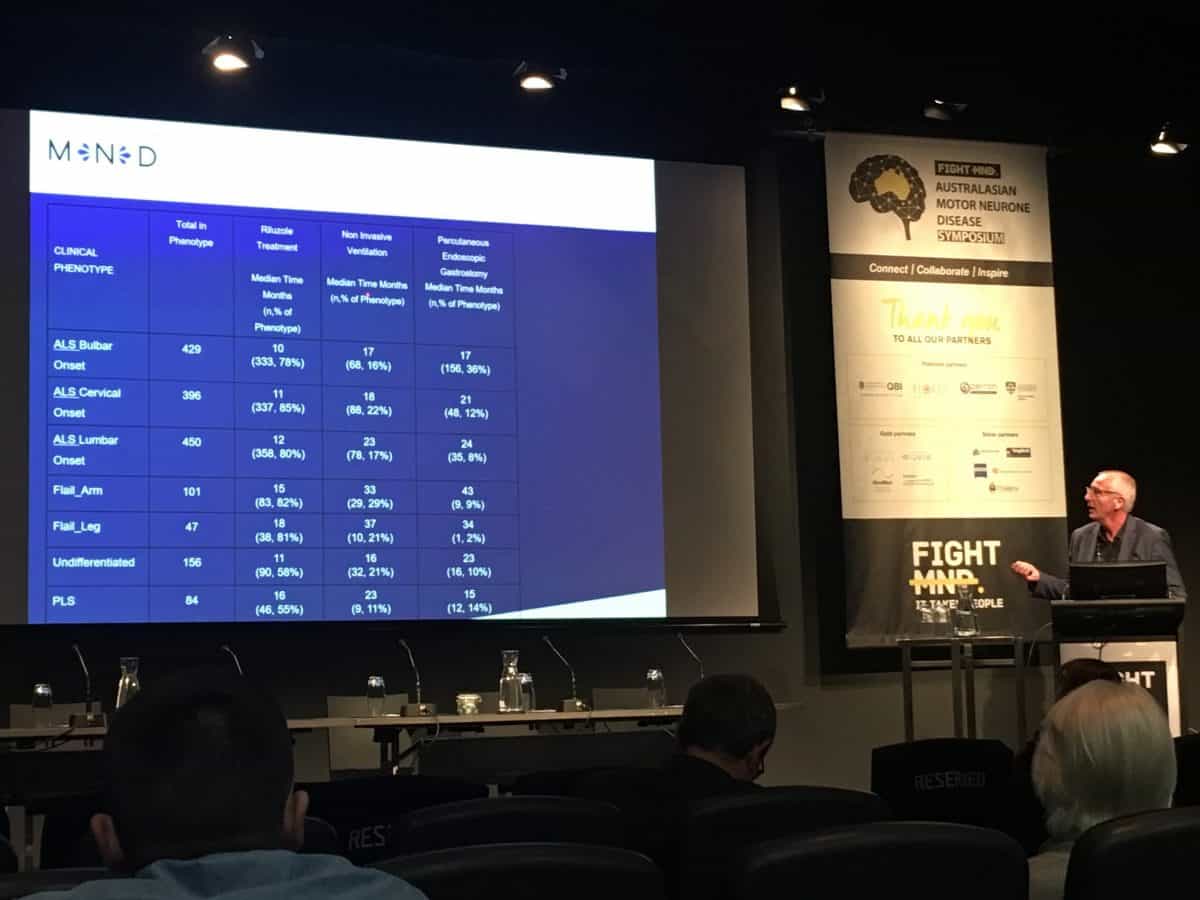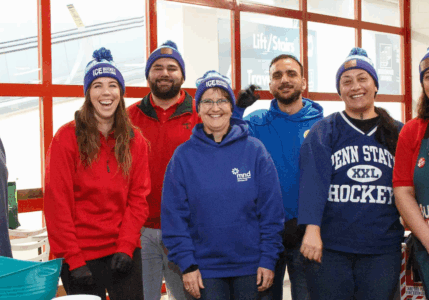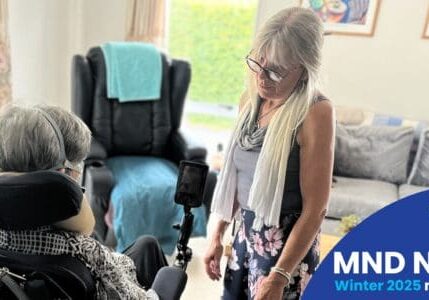Australasian MND Symposium – live blog (Day 3)
Genetics, Research
23 March 2018

Live updates from the Australasian MND Symposium, March 23, 2018.
Written by a non-scientist for a layperson audience. This means we're skipping the complicated science and going straight for the highlights.
Typing fast and editing slow, so excuse spelling mistakes. UPDATES FROM AUSTRALIA AND THE WORLD
8:45am
Carol Birks (CEO, MND Australia) – 10 years of NDIS influencing to ensure early intervention and needs-based supports for pwMND
Our Vision: A world without MND
Our Mission: To promote, influence and advance MND care and research to improve the lives of all Australian impacted by MND
The National Disability Insurance Scheme – opportunity to transform the lives of people with disability (est 2008).
Influencing govt policy is along-term commitment. Requires focus, flexibility, patience. Contributed via submissions, hearings, roundtables, position statements.
Collaborating with other disability organisations, form alliances and collaborations. Neurological Alliance Australia – joint statements and submissions.
Developed NDIS Practice Guide for MND – the first disease-specific practice guide for the NDIS.
State-based Associations worked to communicate with their members, pwMND, to ensure access to NDIS.
Ten years on – people under 65 entitled to NDIS (still advocating for older Australians to be included), progressive neurological conditions IDed as early access group, support plans now accommodate progression, core supports, coordinated supports.
Still – every plan needs to be reviewed and altered, communications remains problematic, ‘value for money' argument is problematic.
Aim to end discriminatory 65 age cap, end denial of supports based on life expectancy.
Prof Paul Talman – Australian MND Registry
What have we learned in the 14 years of the Registry?
Est 2004, pharma had deserted the field after failed clinical trials.
AMNDR created to advance research.
Web-based registration. Minimum dataset aligns with what other international centres are collecting.
Sub-forms for things like genetics, disease mapping.
Can we meaningfully aggregate patients together so we can give them a prognosis when we first see them, anticipate care needs? Set out basic parameters to define UMN and LMN signs to pull out 3 groups: ALS, Flail Limb, PLS.
Looked at major milestones in treatment of patients, and survival probability.
Major change is going from opt-in Registry to opt-out Registry. Opt-in is now thought to be unethical. Opt-out – unless you sign consent to get out, you're in the Register. Very important to get a more accurate population-based analysis.
“I'm really optimistic for the future for the next 5 to 15 years… It WILL lead to a cure.”
Speaker from Australian Clinical Trials: There are lots of cracks in the wall of the dam. It will crack, and of all the neurological diseases MND will crack first.
A/Prof Brad Turner – Introducing the Fight MND screening programme
High disease variability, lack of sporadic MND models, lack of human models, lackof investment in large-scale drug screening in Australia.
Last year a $5 million programme was funded by Victoris Stage Govt, Figth MND and Balcon Group. Objective: rapid screening for sporadic MND.
Use iPS (stem cells) – collect from pwMND and reprogramme into iPS cell lines. Take skin biopsy from forearm, culture skin cells (fibroblasts), turn into iPS cells, reprogram into motor neurons. End up with ‘MND in a dish'. Takes 3-4 months to create.
Funded to collect 150 pwMND and 30 controls.
High throughput drug screening. Uses robots and automation to test existing drug libraries. Use a live cell microscope to hopefully identify drug hits.
Just ordered first drug library: 4,500 prescription meds.
Programme launched Sept 2017 with equipment ordered, finding phsyical space etc. Been doing 20 patient sample collections per month since December. By July 2018 will be into serious high throughput drug testing.
Programme originally focused on Victoria, but people have flown interstate to be part of the programme. Early onset disease is model patient because responds well in the petri dish. Patient recruitment is ongoing. Register at Fight MND website, click ‘drug screening platform'.
Prof Jeremy Shefner – Global MND clinical trials update
An impossible task to give a full global update on clinical trials.
Although we have not cured MND, we have progressed in last ten years – and there are a number of medications we now use for symptom releif and quality of life.
MDT clinics are the biggest advance – patients in MDTs live on average a year longer.
‘Neudexta' significant advance in treating emotional lability.
While we wait for trial to be successful, and we are close than ever before the that happening, ti's important that we continue to treat patients with the disease.
There are many ways we are approaching the ultimate treatment of ALS.
Edaravone: introduction met with a bit of skepticism, similar to that which met riluzole. Reminder that advances are meaningful and incremental. Patients early on in disease with diffuse disease and fast-moving – showed a 33% reduction in rate of progression. Represents a significant advance in ALS care. Lot of work yet to be done to made it easier to administer (currently multiple IV infusions).
Evidence for immune system role: very specific aspects of immune function are altered in ALS. Patients who progress more quickly have highly inflammatory markers (CRP). Clinical trials are looking at anti-inflammatory drugs, eg masitinib.
Masitinib – interim analysis showed significant effect. Not published as some odd things about data. Is still an important drug to investigate further.
MSC drugs work on muscle function.
Tirasemtiv – improves skeletal muscle function. Phase 3 study slowed progression by two-thirds. Unfortunately drug proved very hard to tolerate. 34% of patients felt unwell, unable to continue to take the drug. However int he patients who continued, there was preservation of vital capacity – dropped about one-third slower on the drug.
Second generation version of tirasemtiv has been developed – CK-107. Increases force in muscles. Currently being testing in phase two study.
Stem cell studies. Brainstorm BCT-001-US clinical trial, stem cell treatment injected into spinal fluid. Had some difficulty with tolerability but no severe adverse events. Data encouraging but tentative. At two weeks and 4 weeks reduction in slope of prgression of ALSFRS. Neurotrophic factors increased in spinal fluid. Promising; further clinical trial in progress.
AMX0035 – looks at oxidative cell death of neurons. In a phase two trial.
Acetyl-L-Carnitine (ALC) important in mitochondrial function, shown to be protective against variety of insults. Met primary outcome in 2013, now others are trying to reproduce results.
Therapies for selected populations eg SOD1, c9, UNC13A
“Many of us are very excited about these selected populations being treated better than they are now.”
Other small studies:
- actermra
- retigabine, mexiletine
- mRNAs
- tecfidera
AUSTRALIAN CLINICAL TRIALS SESSION
10:30am
Dr Craig Rosenfeld – Phase 1 study of CuATSM in MND
Copper ATSM is a molecule that is stable, lipophilic, crosses cell membranes and the BBB in ALS patients.
Results in mouse models corroborated in 3 inrst timedependent labs. Fi in 15 years that ALS-TDI has confirmed efficacy of an ALS treatment previously published by others. It extended lifespan in 4 out of 4 mouse models (SOD1).
Delivers copper to motor neurons.
Developed in SOD1 mouse models, so how do know if it will have benefit for sporadic ALS? Anterior horn of brain in pwMND is copper deficient.
Objectives of clinical trial: evaluate safety and tolerability of single and repeated oral dosage. Secondary objective to assess changes over 6 months. Open-label study (no placebo).
Results: safety data collected for four dose levels, efficacy data collected for three dose levels.
Efficacy results: mean decrease in ALSRFS of 4.7 points over 6 months. Disease stabilisation of 4 patients. Mean increase in ECAS scores of 8 points over 6 months (14 out of 15 showed improvement).
144mg cohort clinical trial is ongoing – recommended to be dose for phase 2. Phase 1 study should fully complete by end of 2018.
Prof Julian Gold – Phase 2 safety and tolerability
Comes from infectious disease background. Linking retroviruses to MND as a potential cause.
Potential that there may be a unique type of virus that may be the cause of trigger for MND. This type of virus is only transmitted from person to person. ‘Retrovirus'. HIV is retrovirus that took 40 million lives.
Retroviruses have a core of RNA, when attach to a cell the virus injects its core of RNA into the cell then releases an enzyme that converts the RNA into DNA that enters the nucleus of the cell and becomes part of your DNA.
Human Endogenous Retroviruses (HERVS) are one of the most important causes of natural selection, have affected humans for all generations. 8% of our genome is composed of viral DNA that has been integrated into our genome over human history.
We know of 5 retroviruses that are infecting humans now.
Can't find retroviruses in the blood or cerebrospinal fluid. Look for reverse transcriptase. When look at pwMND, higher level of reverse transcriptase (RT) activity compared to controls.
HERV-K is the most recent retrovirus integrated into our genome 100,000 years ago. Exists in 35 places on our chromosome. It's still a whole virus with all the components of a virus. This gene virus can be upregulated and turned on. When turned on, it can infect other cells. You don't catch it like the flu, it's part of your gene.
You find HERV-K in the motor neurons. Is this cause or effect? When introduce HERV-K into mouse, mouse developed MND.
Can antiretroviral drugs impact HERV-K replication?
Initial study to look at safety and tolerability of one drug combination in pwMND.
Found that HIV drugs are effective in blocking lifecycle of HERV-K.
Enrolled 40 patients at 4 sites in Sydney and Melbourne. Treated with Triumeq (combination of 3 drugs in one), a once-a-day tablet. Six months of open-label treatment (no control group). Most patients two years after onset of symptoms, more males than females.
5 patients withdrew during treatment. Serious adverse affects weren't related to the drug. Of 143 other adverse events, 7 possibly drug-related (nausea, rash).
Found Tiumeq safe and well tolerated. No interactions with riluzole.
During baseline phase p75 went up, continued to go up during first 6-8 weeks of trial (same as HIV treatment). Some people ‘responders', others ‘non-responders'. Statistically 5 people should have died over the time of the study, but no one died during the study.
Will continue for further study.
Prof Robert Henderson – A phase 1b study of anti-CD14 (IC14) in MND
IC14 is a chimeric monoclonal antibody to CD14. Has an extensive clinical history and good safety profile. It's a master regulator of immune function and inflammatory response.
Whatever causes MND results in misfolded proteins, which triggers an immune response – this causes inflammation, which causes damage to functional cells. Cell stress leads to motor neuron death leads to motor function loss.
People in this study were more than happy to have a lumbar puncture, which shows how keen pwMND are to participate in research.
All patients completed the study – final patient dosed last week, will be complete by April 18. Interim analysis shows IC14 well tolerated, no adverse events or withdrawals. Biomarker data may suggest modulated inflammatory response.
Planning underway for phase 3 study in rapidly progressing MND.
Believe that immunotherapy has great promise for MND.
Prof Steve Vucic – Tecfidera in ALS (TEALS) study – Phase 2
Largest phase 2 study in Australia. Has not yet started.
MND is an infinitely complicated disorder.
Regulatory T cells – those with higher rates have slower rate of progression of MND. Tregs dysfunctional in ALS.
How can we upregulate these t-cells safely?
Tecfidera (dimethyl fumerate) in clinical use for MS for many years. Has an antioxidant response and anti-inflammatory response. Significantly improves responsiveness of T cells for immunoregulation by Tregs.
TEALS study: will screen 150 pw sporadic ALS. Recruit 120. Hopes to reduce ALSFRS scores by five points over 9 months.
Should have results by early 2019.
Inez de Greef van der Sand – Clinical development of TW001 – oral formulation of edaravone
Treeway drug development/biotech company founded by two men with ALS.
3-step process for drug development: Slow, Halt, Cure.
Edaravone developed by Mitsubishi-Tanabe, several one-hour infusions – five days, weekend, five days, then two week ‘drug holiday'.
Not patient-friendly. If develop an oral version that will be much more patient-friendly, can give every day in a home setting. If can give it daily, efficacy may also be higher. No reason why shouldn't give it every day because patient has oxidative stress every day.
Developed formulation over 5 years. Have done 4 phase 1 studies. Now onto second formulation (TW001): bioavailability of 70-80%.
Is it really the same drug? Yes, active ingredient is exactly the same.
Proven safe and tolerable.
With continuous daily dosing, monthly exposure to drug is 2.8-fold increase over Radicava.
Now coming into fifth clinical study: Europe and Australia. 300 pwMND, 40 week trial but continue dosing til 72 weeks.
Hope to have drug product available by end of this year.
A/Prof Arman Sabat – EMERALD trial, phase two trial of cannabis based medicine extract (CBME) in ALS
About to start at Gold Coast Hospital. Enrolling 30 pwMND. Efficacy is the primary objective. Secondary objective is to evaluate safety, tolerability, effects on pain management.
Six-month trial (14 days titration).
Using CannTrust CBD oil (1:17 THC:CBD) in capsule form.
ALS patients taking cannabis for appetite loss, depression, pain, spasticity and drooling.
One online survey: 91% reported improvement in quality of life.
Cannabis very complex compound, over 400 chemical components. Principal are THV and CBD (cannabiniol) . Var other compounds including terpenes.
Our body has endocannabinoid system (ECS) – ubiquitious lipid signally system found in all vertebrates. Receptors in brain affected by THC. CB2 receptors found in cells of immune system.
CBD is not a CB1 or CB2 receptor agonist. Synergistic activity to THC. Anti-anxiety effect, anti-psychotic effect.
ECS is a vital neuromodulatory system.
Few clinical trials of CBD in MND have looked at symptom management. None have investigated efficacy of cannabinoids in ALS.
Animal models – review of 7 studies demonstrate cannabinoids significantly prolonged survival time.
Researchers and reviewers at ALS Untangled said: “The most logical next step is to conduct a human trial.”
Recommended further reading: Current Therapeutic Cannabis Controversies and Clinical Trial Design Issues,
Ethan Russo
Dr Ton Blunt – PK enhancement of retroviral therapy in HERV-K in ALS-FTD
About half pwMND seem to have reverse transcriptase enzyme (retrovirus) in blood – 5 studies replicate these findings.
In 80s some young HIV patients develop ALS. Partial, transient response to antiretroviral therapy (ART).
How cross BBB? Early stage BSCB breakdown/leakage, could precede motor neuron death.
Only 2% of FDA approved small molecule drugs cross the BBB.
Can we maintain effective drug exposure in tissues?
The human body has multiple compartments. BBB protects CNS compartment. Drug in- and out-flow determine brain exposure.
Like a swimming pool – water flows in and out. Dose of drug like hose into swimming pool. Drain in back could drain pool in seconds.
Multi-drug resistance in brain is like a pool drain/pumps.
‘Pumps' overexpressed in pwMND.
With HIV need chronic daily therapy with ARVT – because of this ability of the brain to ‘pump out' drug therapy.
In principal, if we can block the ‘pumps' we can keep drugs in brain and spinal cord.
The PK enhancer Elacridar is not pharmacologically active, yet maintains therapeutic drug levels in pump-protected ‘sanctuary' parts of brain. Has relatively little effect on drug levels in plasma and peripheral organs.
If combine PK enhancer with FDA approved drugs, you enhance therapeutic drug levels in brain.
Compounds that can normally only be given via IV, now become orally available.
To test: Start with patients who have HERV-K in blood. Use PK-enhancer to drive ARVT drugs into brain. Test with number of biomarkers.
What does success look like?
HIV treatment with HAART combination treatment converted HIV-AIDS from acute death sentence to chronic manageable disease.
Q&A
Criticism – ARVT already cross BBB and are able to suppress HIV in the brain indefinitely if you continue to take them. They're not pumped out by any pump. You don't develop resistance unless you stop taking the drugs.
Response – have to take ARVT for life, not short-term like antibiotics, therefore it exists in ‘sanctuary pockets'.
What isn't Treeway dose-finding in current study? Because want phase 3 with highest chance of success. Maybe afterward will test other dosing schemes.
Only 375 new patients diagnosed with ALS in Australia each year, but many clinical studies. Should probably be thinking about sequential studies.
Why are people with PEGs so often excluded from clinical trial? If medicine if a pill it is for practical reasons. It also gathers a more homogeneous population, to help demonstrate efficacy.
Is any MND reversible? That's the holy grail but no one suggesting possible from current therapies. Don't know of any neurological disease that has been reversed. Just being slowed down. Could bone marrow transplant approach work (eg infusion of stem cells)? We're not smart enough to say we can't do it. In polio, re-innervation of muscles does occur.
Comment about practice effect on ECAS. Those with mild cognitive effect don't show practice effect. Those without, do show practice effect.
What do you tell patients who see clinical drug cannabis being tested, why not access cannabis through other sources? Decision to be made by the patient. Tell them there's really no data. Studies are to start providing information for patients.
ASK THE EXPERTS SESSION
2pm
Prof Ammar Al-Chalabi – What causes MND? Why me?


Prof Kevin Talbot – Why haven't we found a cure yet?

Prof Kevin Eggan – Stem cell sin MND research and treatment – an update
Stem cells can differentiate into other types of cell.
There are many types of stem cells.
- Totipotent – ability to form all lineages of organism eg zygote
- Pluripotent – ability to form all liineages of body eg embryonic stem cells
- Multipotent
- Unipotent
There are already many effective stem cell therapies eg bone marrow transplants.
We're making new red blood cells every day. Produced by a single multi-potent stem cell in the bone marrow.
Has been tried in MND with no obvious success.
“Mesenchymal” stem cells derived from fibroblasts are the basis of the Brainstorm trial, injected into ALS patients.
What are the oldest cells in your body? Neurons in your nervous system. Neurons don't replicate themselves. Substantial ramifications for how brain repairs itself. Once a neuron becomes differentiated, it will never replace.


